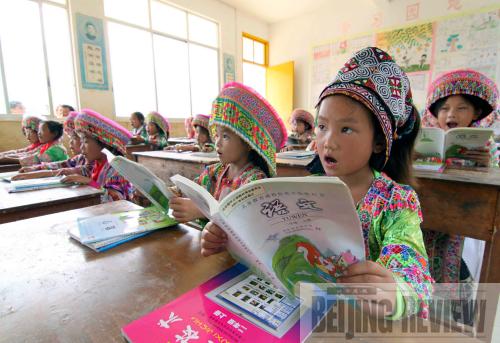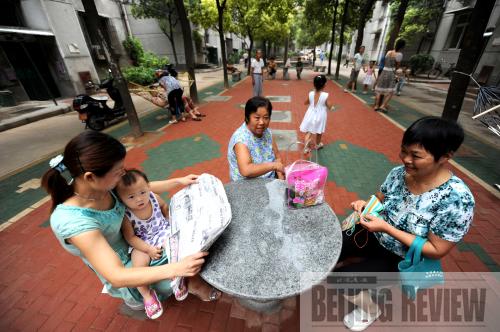|
China adopted a family-planning policy in the early 1970s, and executed a policy permitting urban parents, except ethnic minorities, to have only one child in the early 1980s. The rapid decrease in the birth rate triggered major changes in the population structure, relieving the social pressure that a larger population would have created.
As a result, the people's quality of living has been able to increase. The number of college graduates and skilled workers, as well as the overall quality of the labor force, has been on the rise.
- Eliminating poverty
The number of poverty-stricken people in China's rural areas decreased to 14.87 million in 2007 from 250 million in 1978. A World Bank report released in 2007 said China accounted for 67 percent of the achievements in global poverty reduction in the past two decades. Without China's efforts, the poor population in the world would have continued to grow, it said. China is also the only country that has halved its poor population ahead of schedule, according to the UN Millennium Development Goals.
Poverty relief has entered a new stage since the beginning of the 21st century. The Central Government adopted the Outline for Poverty Alleviation and Development in China's Rural Areas (2001-2010), focusing on eliminating poverty in 592 key poverty-stricken counties by 2010. Meanwhile, it will also commit resources to narrow the gap between urban and rural areas to achieve a balanced growth throughout the country.
- Building a social safety net
China developed a relatively comprehensive social security system, providing a basic foundation for its industrialization and urbanization after the founding of New China. However, the social security system formed under the planned economy had many flaws, covering only a small fraction of the population with weak protection. The living allowance remained unchanged for years.
Beginning in 1984, the government made several initial attempts to reform the flawed social security system. It expanded the coverage of the social security network, raised the living allowance, increased insurance coverage, balanced the burden on different employers, and adopted rules and regulations guiding social security programs. Since then, the social security system has been legalized, standardized, and socialized. Under the planned economy, the government and danwei—state-owned institutions where people worked—were responsible for providing social security. But in the current market economy, employees, the institutions they work for, and the government jointly contribute to the social security network.
 |
|
HOPE FOR THE FUTURE: Children from poverty-stricken families in Yaowo Village in Guangxi Zhuang Autonomous Region read from books they received for free through government assistance programs (LIN BIN) |
In 1993, China officially announced its intentions to establish a socialist market economy. That same year, it also clarified the main content of its social security system and set into motion plans to develop multi-level pension and medical insurance systems by combining social pooling with individual accounts. The social security system reform eventually spread throughout the country, with a focus on introducing pension, medical and unemployment insurances, in a bid to set up a social security system adaptable to the development of the socialist market economy.
In 1994, the Third Plenary Session of the 14th CPC Central Committee passed a resolution to establish a socialist market economy, in which it put forward a systematic plan for China's social security system reform. The document suggested a gradual transition to the system of combining social pooling and individual accounts so as to adapt to China's economic restructuring.
The Sixth Plenary Session of the 16th CPC Central Committee held in 2006 and the 17th CPC National Congress held in 2007 pledged to facilitate the establishment of a social security system covering both urban and rural residents and focusing on basic pension, basic medical care and basic-living guarantee system. At the end of 2008, basic pension insurance for urban residents covered 218.9 million people; basic medical insurance for urban residents covered 316.98 million; unemployment insurance covered 124 million; work injury insurance covered 138.1 million; and maternity insurance covered 91.81 million.
In 2008, 23.34 million urban residents and 42.91 rural residents were covered by the government's basic-living guarantee system. Nearly 50 million migrant workers participated in work injury insurance, and more than 40 million took part in urban medical insurance. Meanwhile, 2,729 counties launched the new rural cooperative medical-care program, covering 814 million, or 91.5 percent of Chinese farmers. The total expenditure of the new rural cooperative medical-care program reached 42.9 billion yuan ($6.28 billion), benefiting 370 million farmers.
China abolished the agricultural tax in 2006, ending the 2,600-year-long tax imposed on farmers. Establishing a social security system, covering not only urban dwellers but also rural residents, is a milestone decision that has put an end to an era when farmers were not covered by any social security plan.
Future tasks
- Applying the Scientific Outlook on Development
China has changed its strategy of development from seeking economic growth at all costs to pursuing comprehensive, balanced and sustainable development—an inevitable transition that the country has achieved as it moves into a new stage of development and modernization. The adjustment means that the government should judge its performance based on improvements in people's living standards instead of GDP growth.
One of the most important lessons China has learned since it adopted its reform and opening-up policy in the late 1970s is that it should promote balanced development between urban and rural areas, as well as between different regions, the economy and society, and even mankind and nature. It must also strike a balance between coordinating development at home and opening up to the outside world. As China jumpstarts its economy, it should properly address problems in employment, income distribution, social security, education, medical care, housing, public security and environmental protection.
- Focusing on improving livelihoods
China's experience in seeking development since 1949 has shown that it is not reasonable to put production before consumption, nor is it sensible to achieve economic growth at the cost of social development. Social programs aimed at improving people's lives can also bring about economic benefits. For example, medical care services can fuel the development of the pharmaceutical industry; efforts to build a green environment can help the landscaping industry prosper; and investment in education always generates better returns than investment in assets.
As it improves people's livelihoods, China will be able to increase its domestic demand. A large consumer market at home, in turn, will make it more competent to cope with drastic fluctuations in the world economy.
- Balancing social and economic development
 |
|
ENJOYING LIFE: Residents of Wuhan City, provincial capital of Hubei Province, spend some quality time with their friends in a community newly refurbished by the government (YU GUOQING) |
In a bid to promote social development, the Chinese Government needs to increase funding for the provision of public goods and services. At the same time, it should bear in mind that welfare levels tend to keep rising despite economic cycles. As a developing country, China should seek social development in light of its economic growth so that social programs do not become a burden on its economy.
- Allocating resources efficiently
China is not a rich country. In fact, the Chinese Government is experiencing financial strains in all sectors of social development. It should not, however, boost its coffers by collecting taxes, because heavy taxes will make Chinese companies less competitive in the international market. The only way out is to allocate resources efficiently by taking into consideration both economic and social benefits. It needs to establish a sound resource allocation system by which to determine how to use poverty alleviation funds to the benefit of more needy people, how to spend money on environmental protection more effectively and how to distribute educational resources more equitably.
The author is Director of the Institute of Sociology, Chinese Academy of Social Sciences, and Chairman of the Chinese Association of Sociology | 
